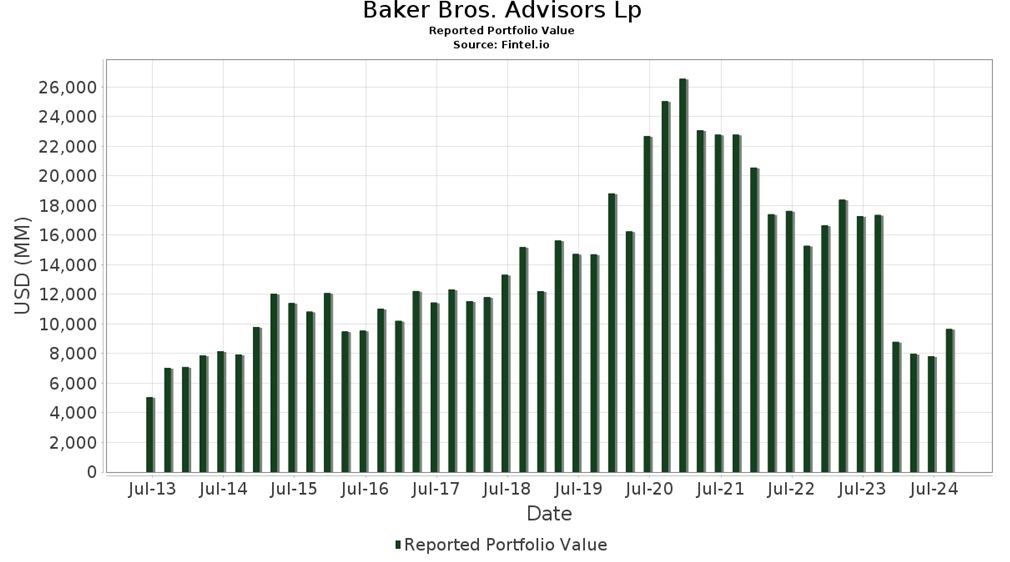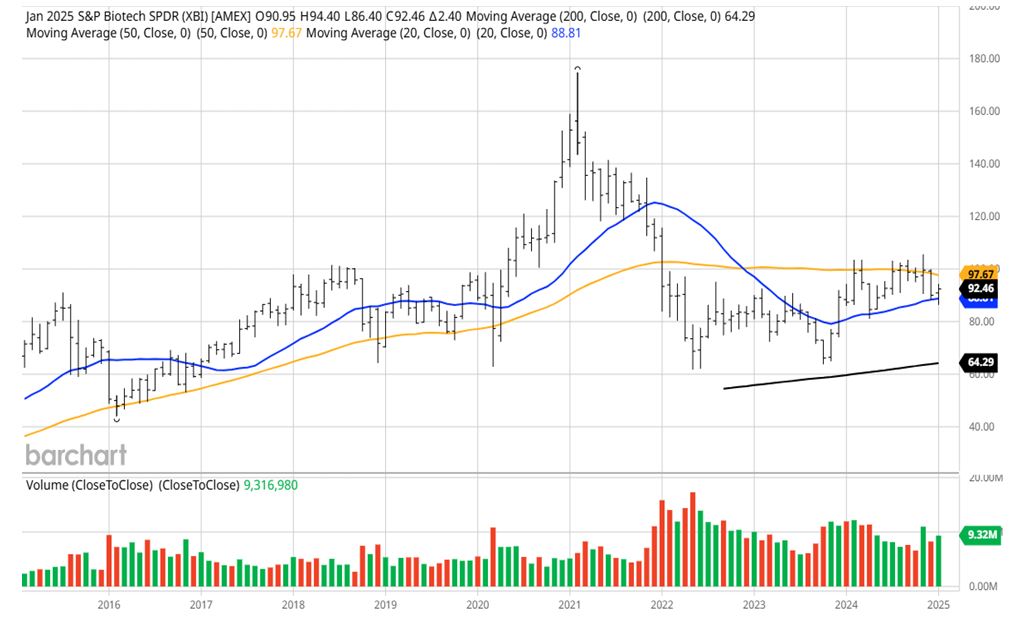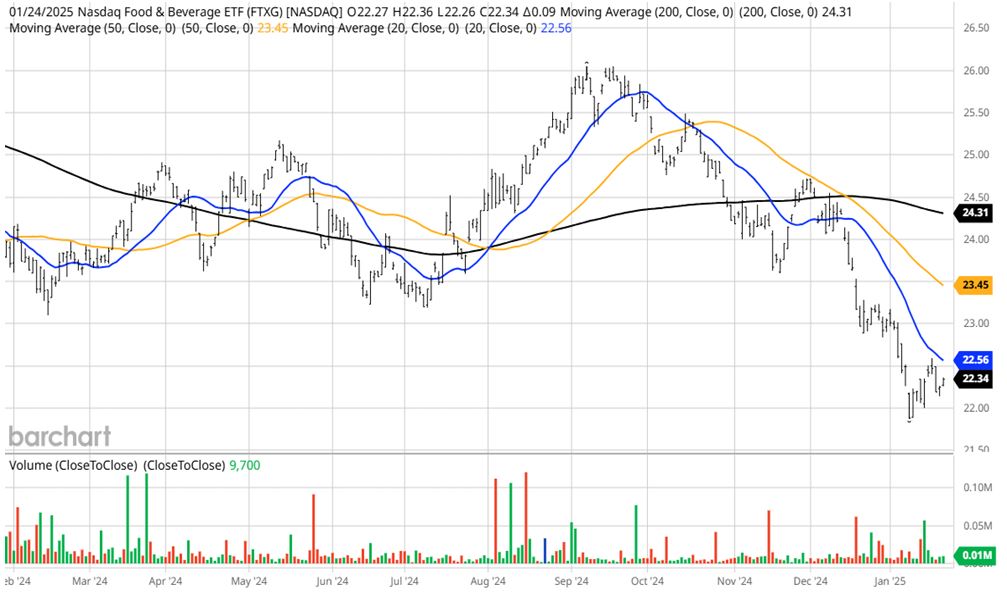by Bryan Perry
January 28, 2025
With the S&P 500 trading at a new all-time high, and Nasdaq not far behind, investors who are squarely positioned in the leading stocks within technology, travel, financial, communications, and the industrial sectors are enjoying the ride. For the most part, market leadership has been narrow, until lately, when we’ve seen growing evidence that market breadth is improving as lagging sectors begin to participate.
Those seeking new places to allocate capital in areas of the market that are out of favor need look no further than healthcare and consumer staples, but there are a couple of themes that should emerge in the year ahead that could bring about a major change in investor sentiment that I think are worth your attention. We often need to see a big catalyst to lift a lagging sector out of its funk enough to commence a transformation that becomes a new secular trend, and I would suggest a couple are already beginning.
AI-Assisted Biotech Research
One of the areas that does not get nearly enough mention as to the future impact of AI is that of medical research, especially the bio-technology space. As a sector that is generally out of favor with the investment community, many of the leading biotech and bio-pharmaceutical stocks and ETFs have sorely lagged in performance over the past two years. But I believe that is about to change.
For 2025, it is my view that there will be a number of new discoveries accelerated by the augment of AI in the R&D labs – like no other time in history. What used to take years and $100 million (minimum) to develop into novel therapies and newly discovered compounds could take just a few months. This would accelerate Phase 1, Phase 2 and Phase 3 of clinical trials to bring advanced drugs to FDA approval.
Imagine the once-seemingly unreachable cures to Alzheimer’s and Parkinson’s diseases finally seeing robust results that stem the effects of each disease with the potential of possibly reversing these life destroying conditions – or rapid advancements in cancer treatments that have been years in the making.
Biotech stocks carry a great deal of risk due to the nature of the business of successful versus failed trials. To this point, I follow the famous bio-technology and bio-pharmaceuticals specific Baker Bros. Advisors hedge fund run by Julian and Charles Baker and look at their top holdings that are also among the top holdings within the most prominent biotech ETFs. The Baker Brothers’ assets under management topped out in 2020 just north of $26 billion and are currently down 63% to $9.6 billion. Talk about falling out of favor.

Graphs are for illustrative and discussion purposes only. Please read important disclosures at the end of this commentary.
The same can be said for most of the widely traded life sciences ETFs. Following huge outflows of assets in recent years, the first signs of positive fund flows emerged in the past couple of months due to what I believe is the promise of what AI will bring to the drug development industry and the potential of delivering phenomenal shrinkage in the time it takes to bring a new drug from Petrie-dish to the market.

Graphs are for illustrative and discussion purposes only. Please read important disclosures at the end of this commentary.
Investors seeking yield and income can utilize some healthcare closed-end funds that have highly attractive yields. The following funds have at least $1 billion in assets:
- BlackRock Health Sciences Term Trust (BMEZ) – Distribution Rate 13.05%
- Abrdn Healthcare Investors (HQH) – Distribution Rate 13.96%
- Abrdn Healthcare Opportunities Fund (THQ) – Distribution Rate 10.58%
Healthier Food Companies
Turning to another out-of-favor market sub-sector – the packaged food and beverage industry – there is a new heart-healthy sheriff in town. With the likely confirmation of Robert F. Kennedy Jr. as Secretary of Health and Human Services this week, his placement in this powerful position will be pivotal to how the food industry will operate. According to Access to Nutrition Foundation (ATNI), around 70% of products sold by the world’s 30 biggest food and beverage companies are unhealthy, and nine are based in the U.S.
Greg Garrett, ATNI executive director, told Newsweek there had been marginal improvements, with 34% of sales coming from healthy foods in 2024, rather than 27% in 2021, “But that’s nowhere near even half,” he said. “If we’re going to get to 50% by 2030, things have to move much faster. It’s still a bleak picture. And … not one of these companies is willing to stop marketing those unhealthy products to children.”
The refined foods and package foods industry that promotes sugar, salt, saturated fat, artificial flavors, artificial colors, additives and preservatives has dominated the regulatory challenge at the Food and Drug Administration for decades. Roughly 35% of Americans are obese, the highest in our nation’s history, leading to cardiac disease, hypertension and a host of related illnesses and debilitating life-threating conditions.
This could all start to change in 2025 as RFK Jr. and his upper management team usher in new standards and mandates on the big food conglomerates, all in order to promote much healthier products, holding companies accountable under new laws and sweeping regulations that will trigger a sea change of how foods and beverages are brought to the marketplace. This wave of change is overdue, but it takes someone like RFK Jr. and others to heighten consumer awareness and take a wrecking ball to the powerful food and beverage special interest groups and lobbies that have had grip on America’s food industry.
Most of the big consumer staples stocks are trading at or near multi-year lows as the S&P 500 trades at new all-time highs. There has to be enormous pressure on the boards and c-suites from the largest institutional shareholders of these companies to forge a strategy to greatly improve shareholder value. That will only come with the launch of new, healthier products. The biggest companies with multiple bad-for-you brands will have to make wholesale changes or continue to see the value of their stocks crumble.

Graphs are for illustrative and discussion purposes only. Please read important disclosures at the end of this commentary.
To this end, I believe that they will do what every public company has to do – pay attention to the bottom line and the price of their stock. Of these major food and beverage companies that stand to make the greatest changes, the worst offenders have the most to gain from making sweeping changes. And at current price levels, several of these stocks pay dividend yields of between 3.5% and 5.5%.
All content above represents the opinion of Bryan Perry of Navellier & Associates, Inc.
Also In This Issue
A Look Ahead by Louis Navellier
The Trump Wildcard Will be Tariffs – How Many and How Big
Income Mail by Bryan Perry
AI and RFK Jr. are Breathing New Life into Two Lagging Sectors
Growth Mail by Gary Alexander
Is This the Most Pro-Growth Administration Since Reagan – or Coolidge?
Global Mail by Ivan Martchev
Watch Out for a Return of Seasonal Inflation
Sector Spotlight by Jason Bodner
Catch a Wave and You’re Sitting on Top of the World
View Full Archive
Read Past Issues Here

Bryan Perry
SENIOR DIRECTOR
Bryan Perry is a Senior Director with Navellier Private Client Group, advising and facilitating high net worth investors in the pursuit of their financial goals.
Bryan’s financial services career spanning the past three decades includes over 20-years of wealth management experience with Wall Street firms that include Bear Stearns, Lehman Brothers and Paine Webber, working with both retail and institutional clients. Bryan earned a B.A. in Political Science from Virginia Polytechnic Institute & State University and currently holds a Series 65 license. All content of “Income Mail” represents the opinion of Bryan Perry
Important Disclosures:
Although information in these reports has been obtained from and is based upon sources that Navellier believes to be reliable, Navellier does not guarantee its accuracy and it may be incomplete or condensed. All opinions and estimates constitute Navellier’s judgment as of the date the report was created and are subject to change without notice. These reports are for informational purposes only and are not a solicitation for the purchase or sale of a security. Any decision to purchase securities mentioned in these reports must take into account existing public information on such securities or any registered prospectus.To the extent permitted by law, neither Navellier & Associates, Inc., nor any of its affiliates, agents, or service providers assumes any liability or responsibility nor owes any duty of care for any consequences of any person acting or refraining to act in reliance on the information contained in this communication or for any decision based on it.
Past performance is no indication of future results. Investment in securities involves significant risk and has the potential for partial or complete loss of funds invested. It should not be assumed that any securities recommendations made by Navellier. in the future will be profitable or equal the performance of securities made in this report. Dividend payments are not guaranteed. The amount of a dividend payment, if any, can vary over time and issuers may reduce dividends paid on securities in the event of a recession or adverse event affecting a specific industry or issuer.
None of the stock information, data, and company information presented herein constitutes a recommendation by Navellier or a solicitation to buy or sell any securities. Any specific securities identified and described do not represent all of the securities purchased, sold, or recommended for advisory clients. The holdings identified do not represent all of the securities purchased, sold, or recommended for advisory clients and the reader should not assume that investments in the securities identified and discussed were or will be profitable.
Information presented is general information that does not take into account your individual circumstances, financial situation, or needs, nor does it present a personalized recommendation to you. Individual stocks presented may not be suitable for every investor. Investment in securities involves significant risk and has the potential for partial or complete loss of funds invested. Investment in fixed income securities has the potential for the investment return and principal value of an investment to fluctuate so that an investor’s holdings, when redeemed, may be worth less than their original cost.
One cannot invest directly in an index. Index is unmanaged and index performance does not reflect deduction of fees, expenses, or taxes. Presentation of Index data does not reflect a belief by Navellier that any stock index constitutes an investment alternative to any Navellier equity strategy or is necessarily comparable to such strategies. Among the most important differences between the Indices and Navellier strategies are that the Navellier equity strategies may (1) incur material management fees, (2) concentrate its investments in relatively few stocks, industries, or sectors, (3) have significantly greater trading activity and related costs, and (4) be significantly more or less volatile than the Indices.
ETF Risk: We may invest in exchange traded funds (“ETFs”) and some of our investment strategies are generally fully invested in ETFs. Like traditional mutual funds, ETFs charge asset-based fees, but they generally do not charge initial sales charges or redemption fees and investors typically pay only customary brokerage fees to buy and sell ETF shares. The fees and costs charged by ETFs held in client accounts will not be deducted from the compensation the client pays Navellier. ETF prices can fluctuate up or down, and a client account could lose money investing in an ETF if the prices of the securities owned by the ETF go down. ETFs are subject to additional risks:
- ETF shares may trade above or below their net asset value;
- An active trading market for an ETF’s shares may not develop or be maintained;
- The value of an ETF may be more volatile than the underlying portfolio of securities the ETF is designed to track;
- The cost of owning shares of the ETF may exceed those a client would incur by directly investing in the underlying securities; and
- Trading of an ETF’s shares may be halted if the listing exchange’s officials deem it appropriate, the shares are delisted from the exchange, or the activation of market-wide “circuit breakers” (which are tied to large decreases in stock prices) halts stock trading generally.
Grader Disclosures: Investment in equity strategies involves substantial risk and has the potential for partial or complete loss of funds invested. The sample portfolio and any accompanying charts are for informational purposes only and are not to be construed as a solicitation to buy or sell any financial instrument and should not be relied upon as the sole factor in an investment making decision. As a matter of normal and important disclosures to you, as a potential investor, please consider the following: The performance presented is not based on any actual securities trading, portfolio, or accounts, and the reported performance of the A, B, C, D, and F portfolios (collectively the “model portfolios”) should be considered mere “paper” or pro forma performance results based on Navellier’s research.
Investors evaluating any of Navellier & Associates, Inc.’s, (or its affiliates’) Investment Products must not use any information presented here, including the performance figures of the model portfolios, in their evaluation of any Navellier Investment Products. Navellier Investment Products include the firm’s mutual funds and managed accounts. The model portfolios, charts, and other information presented do not represent actual funded trades and are not actual funded portfolios. There are material differences between Navellier Investment Products’ portfolios and the model portfolios, research, and performance figures presented here. The model portfolios and the research results (1) may contain stocks or ETFs that are illiquid and difficult to trade; (2) may contain stock or ETF holdings materially different from actual funded Navellier Investment Product portfolios; (3) include the reinvestment of all dividends and other earnings, estimated trading costs, commissions, or management fees; and, (4) may not reflect prices obtained in an actual funded Navellier Investment Product portfolio. For these and other reasons, the reported performances of model portfolios do not reflect the performance results of Navellier’s actually funded and traded Investment Products. In most cases, Navellier’s Investment Products have materially lower performance results than the performances of the model portfolios presented.
This report contains statements that are, or may be considered to be, forward-looking statements. All statements that are not historical facts, including statements about our beliefs or expectations, are “forward-looking statements” within the meaning of The U.S. Private Securities Litigation Reform Act of 1995. These statements may be identified by such forward-looking terminology as “expect,” “estimate,” “plan,” “intend,” “believe,” “anticipate,” “may,” “will,” “should,” “could,” “continue,” “project,” or similar statements or variations of such terms. Our forward-looking statements are based on a series of expectations, assumptions, and projections, are not guarantees of future results or performance, and involve substantial risks and uncertainty as described in Form ADV Part 2A of our filing with the Securities and Exchange Commission (SEC), which is available at www.adviserinfo.sec.gov or by requesting a copy by emailing info@navellier.com. All of our forward-looking statements are as of the date of this report only. We can give no assurance that such expectations or forward-looking statements will prove to be correct. Actual results may differ materially. You are urged to carefully consider all such factors.
FEDERAL TAX ADVICE DISCLAIMER: As required by U.S. Treasury Regulations, you are informed that, to the extent this presentation includes any federal tax advice, the presentation is not written by Navellier to be used, and cannot be used, for the purpose of avoiding federal tax penalties. Navellier does not advise on any income tax requirements or issues. Use of any information presented by Navellier is for general information only and does not represent tax advice either express or implied. You are encouraged to seek professional tax advice for income tax questions and assistance.
IMPORTANT NEWSLETTER DISCLOSURE:The hypothetical performance results for investment newsletters that are authored or edited by Louis Navellier, including Louis Navellier’s Growth Investor, Louis Navellier’s Breakthrough Stocks, Louis Navellier’s Accelerated Profits, and Louis Navellier’s Platinum Club, are not based on any actual securities trading, portfolio, or accounts, and the newsletters’ reported hypothetical performances should be considered mere “paper” or proforma hypothetical performance results and are not actual performance of real world trades. Navellier & Associates, Inc. does not have any relation to or affiliation with the owner of these newsletters. There are material differences between Navellier Investment Products’ portfolios and the InvestorPlace Media, LLC newsletter portfolios authored by Louis Navellier. The InvestorPlace Media, LLC newsletters contain hypothetical performance that do not include transaction costs, advisory fees, or other fees a client might incur if actual investments and trades were being made by an investor. As a result, newsletter performance should not be used to evaluate Navellier Investment services which are separate and different from the newsletters. The owner of the newsletters is InvestorPlace Media, LLC and any questions concerning the newsletters, including any newsletter advertising or hypothetical Newsletter performance claims, (which are calculated solely by Investor Place Media and not Navellier) should be referred to InvestorPlace Media, LLC at (800) 718-8289.
Please note that Navellier & Associates and the Navellier Private Client Group are managed completely independent of the newsletters owned and published by InvestorPlace Media, LLC and written and edited by Louis Navellier, and investment performance of the newsletters should in no way be considered indicative of potential future investment performance for any Navellier & Associates separately managed account portfolio. Potential investors should consult with their financial advisor before investing in any Navellier Investment Product.
Navellier claims compliance with Global Investment Performance Standards (GIPS). To receive a complete list and descriptions of Navellier’s composites and/or a presentation that adheres to the GIPS standards, please contact Navellier or click here. It should not be assumed that any securities recommendations made by Navellier & Associates, Inc. in the future will be profitable or equal the performance of securities made in this report.
FactSet Disclosure: Navellier does not independently calculate the statistical information included in the attached report. The calculation and the information are provided by FactSet, a company not related to Navellier. Although information contained in the report has been obtained from FactSet and is based on sources Navellier believes to be reliable, Navellier does not guarantee its accuracy, and it may be incomplete or condensed. The report and the related FactSet sourced information are provided on an “as is” basis. The user assumes the entire risk of any use made of this information. Investors should consider the report as only a single factor in making their investment decision. The report is for informational purposes only and is not intended as an offer or solicitation for the purchase or sale of a security. FactSet sourced information is the exclusive property of FactSet. Without prior written permission of FactSet, this information may not be reproduced, disseminated or used to create any financial products. All indices are unmanaged and performance of the indices include reinvestment of dividends and interest income, unless otherwise noted, are not illustrative of any particular investment and an investment cannot be made in any index. Past performance is no guarantee of future results.
